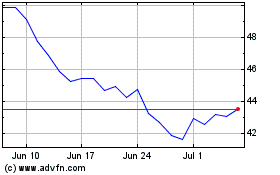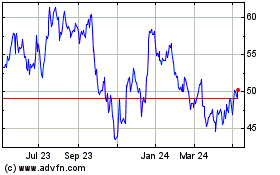TIDMIPO
IP Group PLC
02 December 2016
FOR RELEASE ON 02 December 2016
Portfolio company Genomics and WTCHG first to sequence multiple
human genomes using portfolio company Oxford Nanopore Technologies'
device
IP Group plc (LSE: IPO) ("IP Group" or "the Group"), the
developer of intellectual property-based businesses, is pleased to
note that portfolio company Genomics plc ("Genomics") and Oxford
University's Wellcome Trust Centre for Human Genetics ("WTCHG")
confirmed they have sequenced and analysed multiple human genomes
using hand-held technology from portfolio company Oxford Nanopore
Technologies Ltd ("Nanopore").
Using Nanopore's portable MinION sequencer, the WTCHG and
Genomics team sequenced a standard human reference sample, NA12878.
In addition, in collaboration with the NIHR Oxford Biomedical
Research Centre, they sequenced the DNA from a clinical
patient.
Alan Aubrey, Chief Executive of IP Group, said: "It's exciting
to see two of our portfolio companies collaborating in this world
first. Nanopore has made significant scientific and commercial
progress this year, is starting to gain real traction in industry
and is being recognised at the highest levels. Genomics, meanwhile,
is emerging as the leading genome analytics company. We remain
excited about the prospects of both businesses."
The full announcement from the WTCHG and Genomics follows.
For more information, please contact:
IP Group plc www.ipgroupplc.com
+44 (0) 20 7444 0050
Alan Aubrey, Chief Executive Officer
Greg Smith, Chief Financial Officer +44 (0) 20 7444 0062/+44 (0)
Liz Vaughan-Adams, Communications 7979 853802
Charlotte Street Partners
Andrew Wilson +44 (0) 7810 636995
Notes for editors
About IP Group
IP Group is a leading intellectual property commercialisation
company which focuses on evolving great ideas, mainly from its
partner universities, into world-changing businesses. The Group has
pioneered a unique approach to developing these ideas and the
resulting businesses by providing access to business building
expertise, capital (through its 100%-owned FCA-authorised
subsidiary IP Capital), networks, recruitment and business support.
IP Group has a strong track record of success and its portfolio
comprises holdings in approximately 80 early-stage to mature
businesses across four main sectors -- Biotech, Cleantech,
Healthcare and Technology. The Company is listed on the Main Market
of the London Stock Exchange under the code IPO.
For more information, please visit our website at
www.ipgroupplc.com.
Wellcome Trust Centre for Human Genetics and Genomics plc First
to Sequence Multiple Human Genomes using hand-held Nanopore
Technology
Demonstrates potential for wide-scale whole-genome sequencing in
humans using nanopore approaches
Oxford, UK, December 1, 2016: Oxford University's Wellcome Trust
Centre for Human Genetics (WTCHG) and the leading genome analytics
company Genomics plc today announced the first sequencing and
analysis of multiple human genomes using nanopore technology. The
announcement, made on Thursday at the Oxford Nanopore Community
Meeting in New York City, marks a major breakthrough in sequencing
technology in opening up the potential of wide-scale whole-genome
sequencing in humans using nanopore approaches.
Today's announcement raises the possibility of a major change to
both the economics and the science of DNA sequencing. Researchers
at the WTCHG and Genomics plc used the MinION sequencer developed
by Oxford Nanopore Technologies. The portable MinION is a hand-held
device about the size of a Mars bar, and is powered by a laptop
computer to which it connects via a USB port. It is available for
$1,000 plus the cost of consumables. While nanopore sequencing has
been available for two years, it has previously only been
practicable to apply it to relatively small genomes or regions of
DNA, such as the much smaller genomes of viruses and bacteria.
Recent upgrades to the technology have now made it possible for
researchers to conduct larger-scale studies such as sequencing
complete human genomes by using multiple MinIONs.
A key strength of nanopore sequencing is that reads can be much
longer than is possible with other scalable sequencing
technologies. Longer reads offer significant advantages in human
genome sequencing, enabling researchers to obtain good sequence
data from certain biologically important regions of the genome
which are difficult to study using existing sequencing
technologies. The long reads also appear to make it easier to
detect large structural changes in individual genomes.
The WTCHG and Genomics team sequenced a standard human reference
sample, NA12878. In addition, in collaboration with the NIHR Oxford
Biomedical Research Centre, they sequenced the DNA from a clinical
patient.
Dr Rory Bowden, Deputy Head of High-Throughput Genomics at the
WTCHG, and one of the leaders of the project, said: "It is a
significant breakthrough to sequence multiple human genomes with
nanopore technology. Moving forward, the idea that there will be
alternative technologies with new properties in this space will be
very appealing to researchers and to clinical geneticists."
Professor Michael Simpson, Co-Head of Science at Genomics plc,
another project leader, said: "It is particularly encouraging to
show that nanopore sequencing works for routine clinical samples,
where the amount and quality of DNA available for sequencing may be
constrained. Further, in the clinical sample, the long reads
provided by nanopore technology were critical in confirming the
genetic changes responsible for the patient's condition."
Professor Peter Donnelly, Director of the WTCHG and a Founder
and Director of Genomics plc, said: "The WTCHG were one of the
pioneers of whole-genome sequencing in clinical medicine. We are
delighted to be able to work with nanopore technology to sequence
and analyse a reference and a clinical human genome, and to explore
the potential for large-scale human sequencing using nanopore
approaches."
ENDS
For further information please contact:
Zyme Communications
Lorna Cuddon
Tel: +44 (0)7811996942
Email: lorna.cuddon@zymecommunications.com
Chris McIntyre
Media Relations Manager
University of Oxford
Tel: +44 (0)1865 270 046
Email: christopher.mcintyre@admin.ox.ac.uk
About the Wellcome Trust Centre for Human Genetics
www.well.ox.ac.uk
The Wellcome Trust Centre for Human Genetics is a large
interdisciplinary research centre comprising 400 scientists in 45
research groups, within the University of Oxford. It is one of the
leading institutes, globally, in human genetics. Since its founding
21 years ago, the WTCHG has played a pioneering role in the
progress and success of human disease genetics. The Centre's focus
is the development and implementation of novel approaches to
exploit human genetics and uncover disease biology so as to improve
healthcare.
About Genomics plc www.genomicsplc.com
Genomics plc is one of the leading companies in the genome
analytics space. It combines world-leading expertise in statistical
genetics and data mining with a unique integrated database linking
genotypes and phenotypes, in order to learn about human biology in
humans. Through collaborations with pharmaceutical companies such
as Biogen, Eisai, Merck and Vertex, it applies this approach in
drug development, where genetic analysis of targets and biological
pathways can materially de-risk development programmes. The
company, based in Oxford and founded by world-leading academics
from the Wellcome Trust for Human Genetics and Oxford's Big Data
Institute, is also Analytical Partner to Genomics England's GENE
Consortium (Genomics Expert Network for Enterprises) which
comprises pharmaceutical companies participating in the 100,000
Genomes Project. The Company is supported by some of the UK's
largest investors in life sciences.
About the NIHR Oxford Biomedical Research Centre
http://oxfordbrc.nihr.ac.uk/
The NIHR Biomedical Research Centre, Oxford (OxBRC) is based at
the Oxford University Hospitals NHS Foundation Trust and run in
partnership with the University of Oxford. It was one of five
centres funded by the National Institute for Health Research (NIHR)
in 2007 through a competitively awarded grant of GBP57m over five
years. In April 2012, as a recognition for its outstanding
contribution to healthcare research it was awarded GBP95.5m to 2017
and in September 2016 was awarded GBP113.7m for 2017 to 2022 to
support translational research. Oxford Biomedical Research Centre
genomics researchers are currently sequencing 500 clinical genomes,
one being the clinical sequence described herein, as part of a
programme funded by the Health Innovation Challenge Fund
http://www.hicfund.org.uk/.
Project Funding. The nanopore sequencing described above was
funded by the Wellcome Trust.
This information is provided by RNS
The company news service from the London Stock Exchange
END
NRATBBBTMBIMTJF
(END) Dow Jones Newswires
December 02, 2016 02:01 ET (07:01 GMT)
Ip (LSE:IPO)
Historical Stock Chart
From Mar 2024 to Apr 2024

Ip (LSE:IPO)
Historical Stock Chart
From Apr 2023 to Apr 2024
